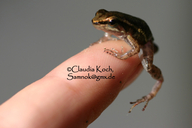|
Hyloxalus elachyhistus (Edwards, 1971)
| family: Dendrobatidae subfamily: Hyloxalinae genus: Hyloxalus |
 © 2011 Claudia Koch (1 of 4) |
|
|
|
Description A tadpole in Stage 34 has a body length of 10.8 mm and a total length of 32.5 mm; the body is ovoid and much wider than high. The snout is bluntly rounded in dorsal view and in profile; the large eyes are situated dorsally, directed dorsolaterally, and not visible from below. The spiracle is sinistral; the tube is short and attached to the body throughout its length. The spiracular opening is directed posterodorsally well below midline at about midlength of the body. The cloacal tube is dextral, short, and attached to ventral fin. The caudal musculature is robust, equal height throughout the proximal one-third of the tail, and gradually diminishes to a pointed tip. The dorsal fin originates on the caudal musculature, is highest at about three-fourths the length of the tail, and gradually diminishes to an acutely rounded tip. The ventral fin originates on the body and is highest at about two thirds the length of the tail. The oral disc is directed anteroventrally. The median half of the anterior labium is bare; elsewhere the labia bear a single row of moderately long, pointed marginal papillae. The labia have shallow lateral folds; submarginal papillae are absent. The jaw sheaths are moderately robust and coarsely serrate; the anterior sheath is in the form of a broad arch, and the posterior sheath is broadly V-shaped. The labial tooth row formula is 2(1)/3; A2 is slightly longer than the other rows. In life, the body is olive gray and the tail is yellow proximally, becoming more orange distally, flecked with gray. In preservative, the dorsum and sides of the body are brown, and the belly is translucent gray; caudal musculature is pale creamy tan with brown flecks, and the caudal musculature is translucent with brown flecks. Distribution and Habitat Country distribution from AmphibiaWeb's database: Ecuador, Peru
Life History, Abundance, Activity, and Special Behaviors
References
Coloma, L. A. (1995). Ecuadorian Frogs of the Genus Colostethus (Anura: Dendrobatidae). Museum of Natural History, University of Kansas, Lawrence, Kansas. Duellman, W. E. (2004). ''Frogs of the genus Colostethus (Anura; Dendrobatidae) in the Andes of northern Peru.'' Scientific Papers of the Natural History Museum, University of Kansas, 35, 1-49. Edwards, S. R. (1971). ''Taxonomic notes on South American Colostethus with descriptions of two new species.'' Proceedings of the Biological Society of Washington, 84, 147–162. Originally submitted by: William Duellman (first posted 2004-12-10) Edited by: Kellie Whittaker (2007-12-03) Species Account Citation: AmphibiaWeb 2007 Hyloxalus elachyhistus <https://amphibiaweb.org/species/1558> University of California, Berkeley, CA, USA. Accessed Jan 17, 2025.
Feedback or comments about this page.
Citation: AmphibiaWeb. 2025. <https://amphibiaweb.org> University of California, Berkeley, CA, USA. Accessed 17 Jan 2025. AmphibiaWeb's policy on data use. |



 Map of Life
Map of Life